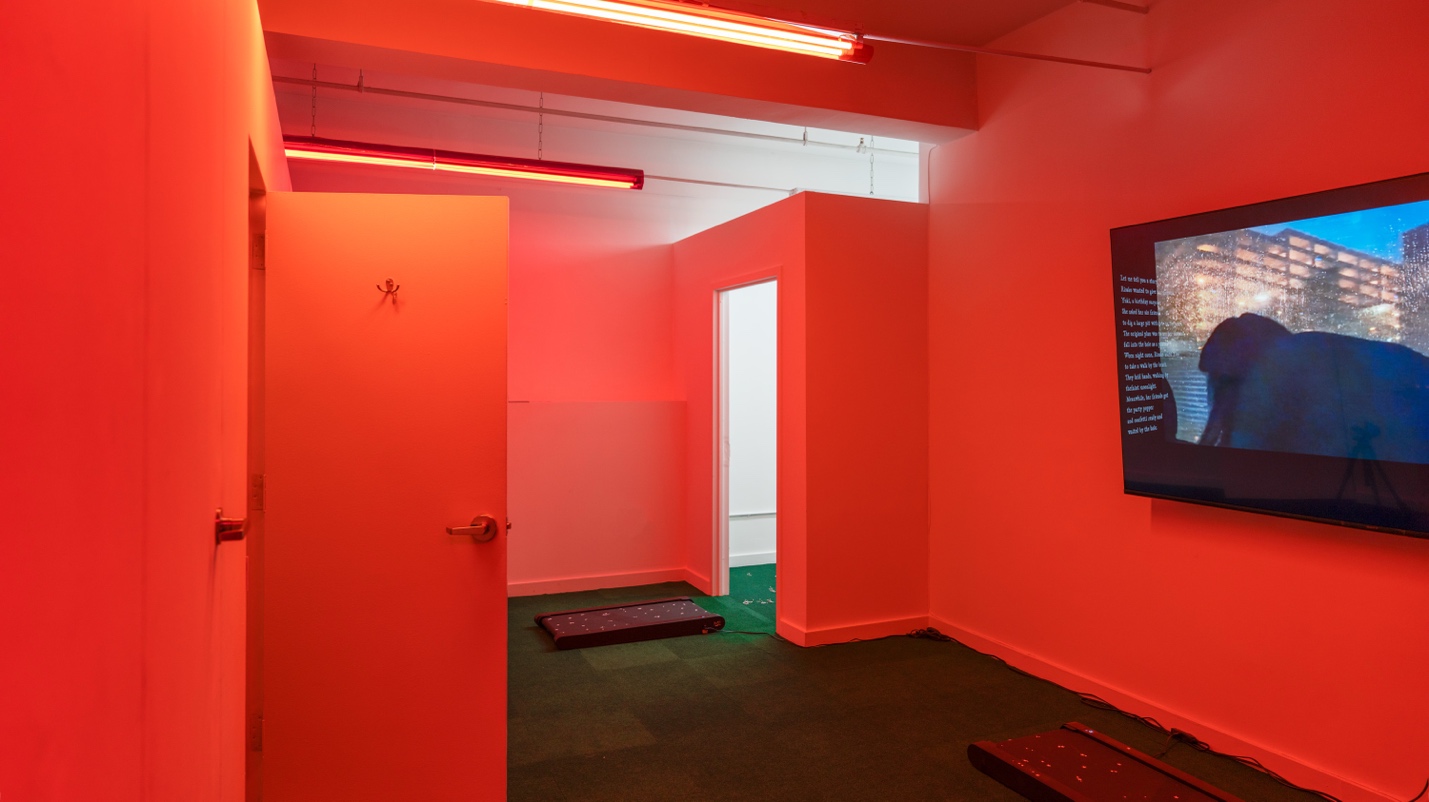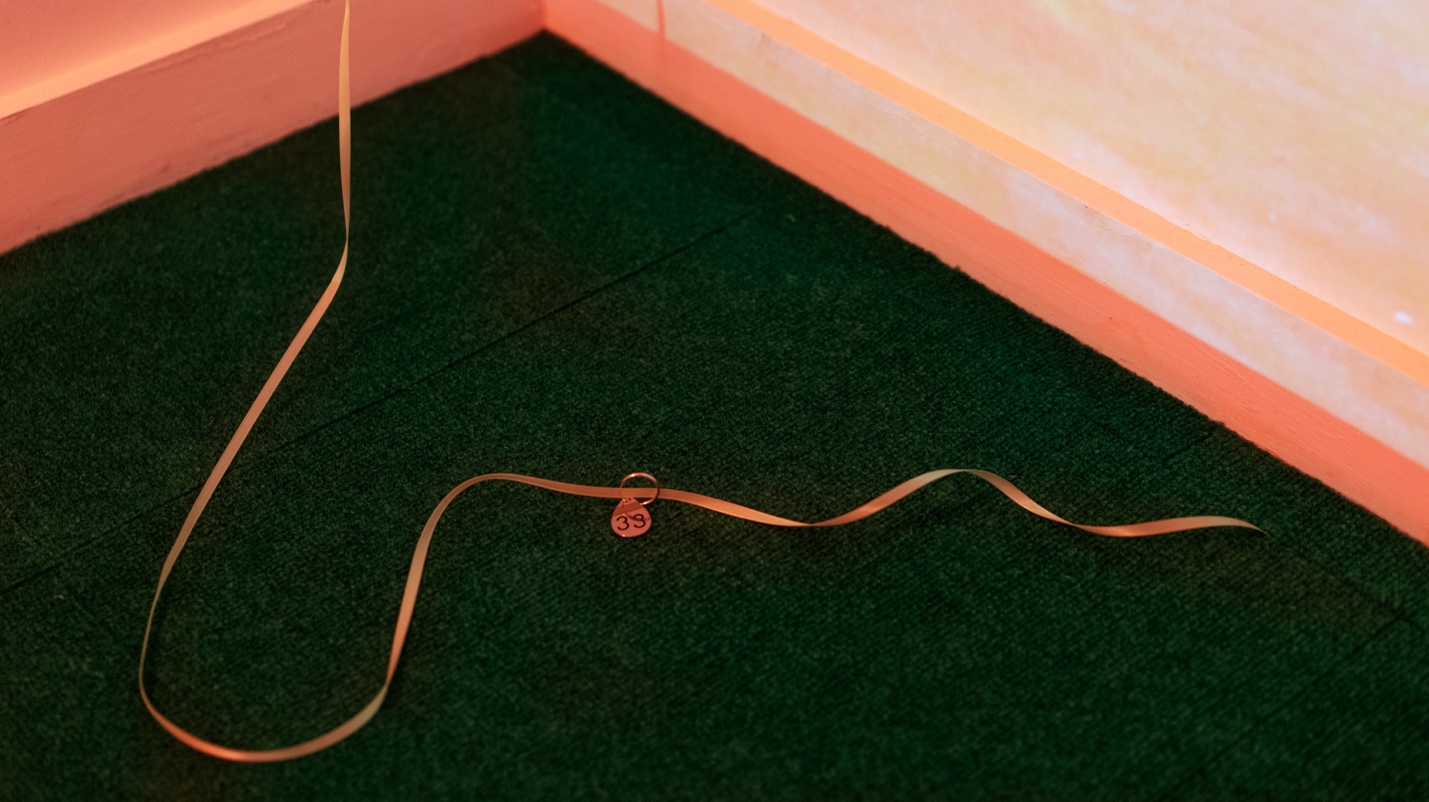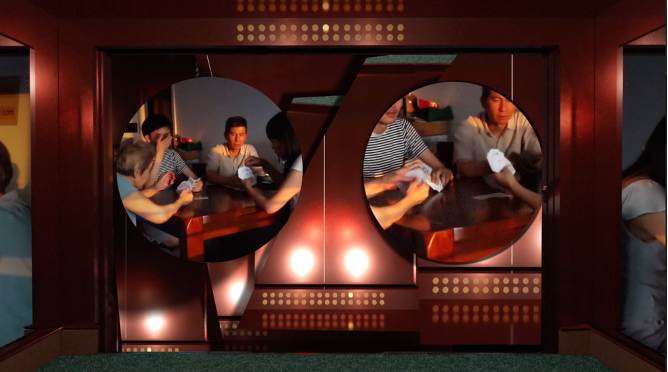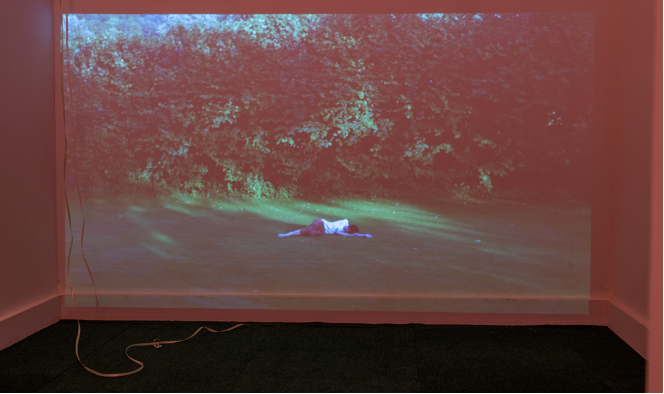Amiko Li’s ‘Nothing to do here but Wait’ at Mandarin Express


Amiko Li’s solo exhibition, Nothing to do here but Wait, is tucked inside a renovated 19-story multi-tenant building. Presented by the non-profit art initiative Mandarin Express, one arrives at the pop-up gallery down a windowless corridor and past a series of identical yellow doors, each jarringly lit with overhead fluorescent lighting. Working across photography, film, and performance, Li’s interior exhibition, dialogues with the hallway to it. Disorienting art-seeing experiences are not necessarily unique in New York City, but using disorientation as a mechanism is less common and is particular to Li’s site-specific installations which frame his exploration of destabilizing and liminal spaces.
Nothing to do here but Wait is designed as a series of encounters, with each moment offering an illusion of choice. Entering the exhibition, one steps into a waiting room of sorts. The narrow space shares the corridor’s fluorescents with a patchy, green carpet flooring that softens the harsh lighting. Small metal number tags are scattered across the ground, shifting the viewer’s attention away from the otherwise bare, white room. Metallic numbers, reminiscent of elevator buttons, are affixed to the wall and positioned by a door leading into the next space. The top of this wall has been built shorter than its walls, allowing the following room’s ominous red lighting and narrative audio to seep in. Both the tags and wall-mounted digits are deceptively interactive, an engagement subtly encouraged by the lack of signage discouraging touch, and the near impossibility of avoiding the tags underfoot. Viewers decide when to enter the next gallery, and how much damage the tags will incur, depending on how wide they swing the door open. A crisp, percussive sound chimes out when this happens—a delightful moment of discovery that contrasts the disconcerting atmosphere.

A sense of abrupt encounter continues in the second room, where a moving conveyor belt runs along the floor near the entrance, directly placed in front of a wall with four doors—only two of which open to adjoining smaller rooms. These elements suggest different ways to navigate the exhibition: one can experience it with motion by standing on the belt, and there is no set order for opening and entering the doors. Three additional conveyor belts are placed around this second and main gallery, each looping at its own pace. There’s a playfulness in their comically short length and the whimsical embellishing of cut-out paper stars. This youthful, delicate detail is echoed in the loose satin ribbons that hang in the smaller rooms, juxtaposed with a series of M.C. Escher–inspired 3D-rendered “impossible staircases” prints and 3D-printed sculptures that speak to the overall themes of paradoxical illusion.

The eponymous film, Nothing to do here but Wait (2025), plays in the red-tinted main gallery and can be heard before being seen, reminding viewers of the installation’s artifice and the artist’s meticulous worldbuilding throughout the exhibition. Its meta-script not only describes the exhibition design (“green carpet on the floor / metallic door / seems like an elevator room but slightly bigger”) but also narrates and affirms the viewing experience: “Here is the thing, when the door is opened, it’s not up to you anymore. You don’t get to decide what to see.” The moving-image work unfolds primarily in a computer-rendered elevator. As the door opens and closes, it reveals a sequence of mundane archival footage. Each tied to a different floor, these fragmented videos allude to hypnotic memories, presented through a vertical passage of space and time.
The film articulates the central thesis of the exhibition: a meditation on personal uncertainty and paralysis in the face of overwhelming choices. The narrator suggests “[choosing] the floor with least resistance,” and more cautiously, to “wait,” concluding that “the best thing to do is to stay put.”

A second video piece, In Anticipation (2025), is projected onto the wall of an adjoining room and visualizes what escapist waiting might look like. Shot mostly outdoors, the short film features Li himself, seated and lying in a lush green park, while the camera lingers and kills time. On the floor in front of this projection lies a metal tag numbered “33” threaded with a silver ribbon. The artist revealed this to be his age—a small but poignant detail that gestures toward a quiet confrontation with mortality, and the existential weight of our everyday actions and choices. With Li’s intimate curation, Nothing to do here but Wait as an exhibition rewards patient, attentive engagement, advocating for intentional, active viewing and experience in today’s fast-paced, spectacle-driven world.
Amiko Li: Nothing to do here but Wait is on view through October 25, 2025 at Mandarin Express, 147 West 35th St, #211, New York, NY 10001.
You Might Also Like
Recalling Nǚshū, a Secret Women’s Language, Poet JinJin Xu Knocks Words in Shanghai Exhibition
In Stuttgart, CURRENT Reclaims Air as a Mode to Rethink Public Space
What's Your Reaction?
Annette An-Jen Liu is a Taiwanese writer and early-career curator working between Taipei and New York City. Her practice is informed by her studies in photography and anthropology in Australia. She is a 2023 recipient of the Andy Warhol Foundation Arts Writer Grant.

